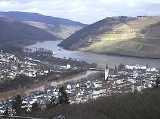
Bingen am Rhein
Encyclopedia
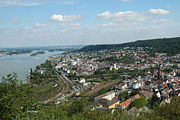

Mainz-Bingen
Mainz-Bingen is a district in the east of Rhineland-Palatinate, Germany. Neighboring districts are Rheingau-Taunus, the district-free cities Wiesbaden and Mainz, the districts Groß-Gerau, Alzey-Worms, Bad Kreuznach, Rhein-Hunsrück.-History:During the French occupation under Napoleon the district...
district in Rhineland-Palatinate
Rhineland-Palatinate
Rhineland-Palatinate is one of the 16 states of the Federal Republic of Germany. It has an area of and about four million inhabitants. The capital is Mainz. English speakers also commonly refer to the state by its German name, Rheinland-Pfalz ....
, Germany
Germany
Germany , officially the Federal Republic of Germany , is a federal parliamentary republic in Europe. The country consists of 16 states while the capital and largest city is Berlin. Germany covers an area of 357,021 km2 and has a largely temperate seasonal climate...
.
The settlement’s original name was Bingium, a Celtic
Celtic languages
The Celtic languages are descended from Proto-Celtic, or "Common Celtic"; a branch of the greater Indo-European language family...
word that may have meant “hole in the rock”, a description of the shoal
Shoal
Shoal, shoals or shoaling may mean:* Shoal, a sandbank or reef creating shallow water, especially where it forms a hazard to shipping* Shoal draught , of a boat with shallow draught which can pass over some shoals: see Draft...
behind the Mäuseturm, known as the Binger Loch. Bingen was the starting point for the Via Ausonia, a Roman
Ancient Rome
Ancient Rome was a thriving civilization that grew on the Italian Peninsula as early as the 8th century BC. Located along the Mediterranean Sea and centered on the city of Rome, it expanded to one of the largest empires in the ancient world....
military road that linked the town with Trier
Trier
Trier, historically called in English Treves is a city in Germany on the banks of the Moselle. It is the oldest city in Germany, founded in or before 16 BC....
. Bingen is well known for, among other things, the story about the Mouse Tower
Mouse Tower
The Mouse Tower is a stone tower on a small island in the Rhine, outside Bingen am Rhein, Germany. The Romans were the first to build a structure on this site. It later became part of Franconia, and it fell and had to be rebuilt many times....
, in which allegedly the Bishop of Mainz
Mainz
Mainz under the Holy Roman Empire, and previously was a Roman fort city which commanded the west bank of the Rhine and formed part of the northernmost frontier of the Roman Empire...
Hatto was eaten by mice. The town was in 2008, after Kaiserslautern
Kaiserslautern
Kaiserslautern is a city in southwest Germany, located in the Bundesland of Rhineland-Palatinate at the edge of the Palatinate forest . The historic centre dates to the 9th century. It is from Paris, from Frankfurt am Main, and from Luxembourg.Kaiserslautern is home to 99,469 people...
and Trier
Trier
Trier, historically called in English Treves is a city in Germany on the banks of the Moselle. It is the oldest city in Germany, founded in or before 16 BC....
, organizer of the third Rhineland-Palatinate State Garden Show.
Location
Bingen is situated just southeast of the Rhine kneeRhine knee
The Rhine knee is the name of a few bends in the Rhine river.-Rhine knee at Basel:In Basel the Rhine changes its westerly direction of flow to a northerly direction, along the borders of France and Germany, to flow to the North Sea. From a political viewpoint the Rhine knee is near the tripoint of...
at the Bingen Forest (Binger Wald – actually a low mountain range), which rises west of the town. Rising to the north on the other side of the Rhine is the Rheingau
Rheingau
The Rheingau is the hill country on the north side of the Rhine River between Wiesbaden and Lorch near Frankfurt, reaching from the western Taunus to the Rhine. It lies in the state of Hesse and is part of the Rheingau-Taunus-Kreis administrative district...
range, the Taunus
Taunus
The Taunus is a low mountain range in Hesse, Germany that composes part of the Rhenish Slate Mountains. It is bounded by the river valleys of Rhine, Main and Lahn. On the opposite side of the Rhine, the mountains are continued by the Hunsrück...
’s southwesternmost outcrop. In Bingen the river Nahe empties into the Rhine Gorge
Rhine Gorge
The Rhine Gorge is a popular name for the Upper Middle Rhine Valley, a 65 km section of the River Rhine between Koblenz and Bingen in Germany...
. Bingen forms the southern limit of the UNESCO
UNESCO
The United Nations Educational, Scientific and Cultural Organization is a specialized agency of the United Nations...
Rhine Gorge World Heritage Site
World Heritage Site
A UNESCO World Heritage Site is a place that is listed by the UNESCO as of special cultural or physical significance...
. The Rochusberg (mountain) is nearly completely surrounded by the town site.
Constituent communities
|
|
Population development
(each time at 31 December)| Year | 1998 | 2000 | 2002 | 2004 | 2006 | |
| Inhabitants | 24,821 | 24,710 | 24,786 | 24,849 | 24,587 |
History
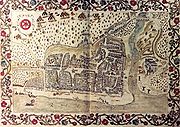


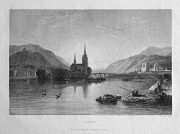
Ancient Rome
Ancient Rome was a thriving civilization that grew on the Italian Peninsula as early as the 8th century BC. Located along the Mediterranean Sea and centered on the city of Rome, it expanded to one of the largest empires in the ancient world....
came, people lived here, because the location favoured transport (confluence of the Nahe and Rhine, and the Rhine’s entry into the gorge), a Celtic (Gaulish
Gauls
The Gauls were a Celtic people living in Gaul, the region roughly corresponding to what is now France, Belgium, Switzerland and Northern Italy, from the Iron Age through the Roman period. They mostly spoke the Continental Celtic language called Gaulish....
) settlement by the name of Binge – meaning “rift”. In the early first century AD, Roman troops were stationed in Bingen on the Rhine Valley Road. They changed the location's name to Bingium. There the Romans erected a wooden bridge across the Nahe and constructed a bridgehead
Bridgehead
A bridgehead is a High Middle Ages military term, which antedating the invention of cannons was in the original meaning expressly a referent term to the military fortification that protects the end of a bridge...
castrum
Castra
The Latin word castra, with its singular castrum, was used by the ancient Romans to mean buildings or plots of land reserved to or constructed for use as a military defensive position. The word appears in both Oscan and Umbrian as well as in Latin. It may have descended from Indo-European to Italic...
. A Roman Mithraic monument, which included a mutilated sculpture representing the nativity of Mithra from a rock, was discovered in Bingen; one of its inscriptions is dated 236.
The presbyter Aetherius of Bingen founded sometime between 335 and 360 a firmly Christian
Christianity
Christianity is a monotheistic religion based on the life and teachings of Jesus as presented in canonical gospels and other New Testament writings...
community. Bearing witness to this time is Aetherius’s gravestone, which can still be seen in Saint Martin’s Basilica. After the fall of the Limes
Limes Germanicus
The Limes Germanicus was a line of frontier fortifications that bounded the ancient Roman provinces of Germania Inferior, Germania Superior and Raetia, dividing the Roman Empire and the unsubdued Germanic tribes from the years 83 to about 260 AD...
, the town became a Frankish
Franks
The Franks were a confederation of Germanic tribes first attested in the third century AD as living north and east of the Lower Rhine River. From the third to fifth centuries some Franks raided Roman territory while other Franks joined the Roman troops in Gaul. Only the Salian Franks formed a...
royal estate and passed in 983 by the Donation of Verona from Otto II
Otto II, Holy Roman Emperor
Otto II , called the Red, was the third ruler of the Saxon or Ottonian dynasty, the son of Otto the Great and Adelaide of Italy.-Early years and co-ruler with Otto I:...
to Archbishop Willigis
Willigis
Saint Willigis was Archbishop of Mainz from 975 until his death as well as a statesman of the Holy Roman Empire.-Life:...
of Mainz. Under Otto III
Otto III, Holy Roman Emperor
Otto III , a King of Germany, was the fourth ruler of the Saxon or Ottonian dynasty of the Holy Roman Empire. He was elected King in 983 on the death of his father Otto II and was crowned Holy Roman Emperor in 996.-Early reign:...
the Binger Kammerforst (forest) came into being. Under Willigis, some way up the river Nahe, the stone Drususbrücke (bridge) was built.
The inhabitants of Bingen strove time and again for independence, which led in 1165 through disputes between the Archbishop of Mainz and the Emperor to destruction. In the 13th century, Bingen was a member of the Rhenish League of Towns. The building of Klopp Castle
Klopp Castle
Klopp Castle is a castle in the town of Bingen am Rhein in the Upper Middle Rhine Valley in Rhineland-Palatinate, Germany. In the nineteenth century, the bergfried or keep from the original medieval fortified castle was restored and a new building added which houses the town's...
(Burg Klopp) in the mid 13th century could well be seen as being tied in with this development. A last attempt was the town’s unsuccessful participation in the German Peasants' War
German Peasants' War
The German Peasants' War or Great Peasants' Revolt was a widespread popular revolt in the German-speaking areas of Central Europe, 1524–1526. At its height in the spring and summer of 1525, the conflict involved an estimated 300,000 peasants: contemporary estimates put the dead at 100,000...
in 1525. From the Archbishop the Cathedral Chapter of Mainz acquired the town in two halves in 1424 and 1438. Until the late 18th century Bingen remained under its administration. Like many towns in the valley, Bingen suffered several town fires and wars.
From 1792 to 1813, the town was, as part of the département of Mont-Tonnerre
Mont-Tonnerre
Mont-Tonnerre is the name of a département of the First French Empire in present Germany. It is named after the highest point in the Rhenish Palatinate, the Donnersberg. It was the southernmost of four départements formed in 1798, when the west bank of the Rhine was annexed by France...
(or Donnersberg – both names meaning “Thunder Mountain”), French after French Revolution
French Revolution
The French Revolution , sometimes distinguished as the 'Great French Revolution' , was a period of radical social and political upheaval in France and Europe. The absolute monarchy that had ruled France for centuries collapsed in three years...
ary troops had occupied the Rhine’s left bank. In 1816, after the Congress of Vienna
Congress of Vienna
The Congress of Vienna was a conference of ambassadors of European states chaired by Klemens Wenzel von Metternich, and held in Vienna from September, 1814 to June, 1815. The objective of the Congress was to settle the many issues arising from the French Revolutionary Wars, the Napoleonic Wars,...
, the town passed to the Grand Duchy of Hesse
Grand Duchy of Hesse
The Grand Duchy of Hesse and by Rhine , or, between 1806 and 1816, Grand Duchy of Hesse —as it was also known after 1816—was a member state of the German Confederation from 1806, when the Landgraviate of Hesse-Darmstadt was elevated to a Grand Duchy, until 1918, when all the German...
-Darmstadt while today’s outlying centre of Bingerbrück went to Prussia
Prussia
Prussia was a German kingdom and historic state originating out of the Duchy of Prussia and the Margraviate of Brandenburg. For centuries, the House of Hohenzollern ruled Prussia, successfully expanding its size by way of an unusually well-organized and effective army. Prussia shaped the history...
’s Rhine Province
Rhine Province
The Rhine Province , also known as Rhenish Prussia or synonymous to the Rhineland , was the westernmost province of the Kingdom of Prussia and the Free State of Prussia, within the German Reich, from 1822-1946. It was created from the provinces of the Lower Rhine and Jülich-Cleves-Berg...
, making Bingen a border town until 1871, when the German Empire
German Empire
The German Empire refers to Germany during the "Second Reich" period from the unification of Germany and proclamation of Wilhelm I as German Emperor on 18 January 1871, to 1918, when it became a federal republic after defeat in World War I and the abdication of the Emperor, Wilhelm II.The German...
was founded.
On 7 June 1969, the formerly Prussian municipality of Bingerbrück was amalgamated. On 22 April 1972 came Dromersheim’s and Sponsheim’s amalgamation with Bingen. The epithet am Rhein has been borne since 1 July 1982.
For the State Garden Show in 2008 in Bingen, the Rhineside areas in the town underwent extensive modernization.
Jewish History
Benjamin of TudelaBenjamin of Tudela
Benjamin of Tudela was a medieval Jewish traveler who visited Europe, Asia, and Africa in the 12th century. His vivid descriptions of western Asia preceded those of Marco Polo by a hundred years...
mentioned a Jewish community in Bingen in the mid 12th century. Christian inhabitants attacked the small Jewish quarter on Rosh Hashanah
Rosh Hashanah
Rosh Hashanah , , is the Jewish New Year. It is the first of the High Holy Days or Yamim Nora'im which occur in the autumn...
in 1198 or 1199, and the Jews were driven from the city. Jews again lived in Bingen as moneylenders in the middle of the 13th century under the jurisdiction of the archbishop of Mainz. In 1343, French Jews settled in Bingen. In 1405, the archbishop declared a moratorium on one-fifth of the debts owed to Jews by Christians, and subsequently the archbishops repeatedly extorted large sums. Noted rabbis who taught in the small community included Seligmann Oppenheim, who convened the Council of Bingen (1455–56) in an unsuccessful attempt to establish his authority over the whole of Rhineland
Rhineland
Historically, the Rhinelands refers to a loosely-defined region embracing the land on either bank of the River Rhine in central Europe....
Jewry. After the proposal was opposed by Moses Minz, the matter was referred to Isaac Isserlein, who rejected the project. The Jews were again expelled from Bingen in 1507, and did not return until the second half of the 16th century. The Jewish population was 465 in 1933, and 222 in 1939 due to flight and emigration. The 169 Jews who remained in Bingen in 1942 were deported, and only four ultimately returned. The synagogue was demolished in 1945, and the community was not reestablished after World War II.
Town council
The council is made up of 36 council members. The Chief Mayor has been since 1996 the CDU politician Birgit Collin-Langen. Her deputy is the CDU politician Thomas Feser. Seats are apportioned thus:| SPD Social Democratic Party of Germany The Social Democratic Party of Germany is a social-democratic political party in Germany... |
CDU | Grüne | FDP Free Democratic Party (Germany) The Free Democratic Party , abbreviated to FDP, is a centre-right classical liberal political party in Germany. It is led by Philipp Rösler and currently serves as the junior coalition partner to the Union in the German federal government... |
FWG | Total | |
| 2004 | 10 | 18 | 3 | 3 | 2 | 36 seats |
(as at municipal election held on 13 June 2004)
Coat of arms
The town’s armsCoat of arms
A coat of arms is a unique heraldic design on a shield or escutcheon or on a surcoat or tabard used to cover and protect armour and to identify the wearer. Thus the term is often stated as "coat-armour", because it was anciently displayed on the front of a coat of cloth...
show Saint Martin
Martin of Tours
Martin of Tours was a Bishop of Tours whose shrine became a famous stopping-point for pilgrims on the road to Santiago de Compostela. Around his name much legendary material accrued, and he has become one of the most familiar and recognizable Christian saints...
cutting off a piece of his cloak for a poor man, and in a small inescutcheon in dexter chief, the Wheel of Mainz
Wheel of Mainz
thumb|150px|version until 1992thumb|150px|version from 1992 - 2008thumb|150px|version from 2008The Wheel of Mainz or Mainzer Rad, in German, was the coat of arms of the Archbishopric of Mainz and thus also of the Electorate of Mainz , in Rhineland-Palatinate, Germany. It consists of a silver wheel...
.


Main sights
- Mouse TowerMouse TowerThe Mouse Tower is a stone tower on a small island in the Rhine, outside Bingen am Rhein, Germany. The Romans were the first to build a structure on this site. It later became part of Franconia, and it fell and had to be rebuilt many times....
- Former monastery church, the Basilica of St. Martin, from the 15th century with RomanesqueRomanesque architectureRomanesque architecture is an architectural style of Medieval Europe characterised by semi-circular arches. There is no consensus for the beginning date of the Romanesque architecture, with proposals ranging from the 6th to the 10th century. It developed in the 12th century into the Gothic style,...
cryptCryptIn architecture, a crypt is a stone chamber or vault beneath the floor of a burial vault possibly containing sarcophagi, coffins or relics.... - Klopp Castle (Burg Klopp)
- RochuskapelleRochuskapelle (Bingen)The Rochuskapelle is a German pilgrimage chapel to Saint Roch on the Rochusberg southeast of Bingen am Rhein.-History:The first building, dating to the plague year of 1666, was destroyed during the campaigns of 1795 in the French Revolutionary Wars of the Rhine valley...
- Drususbrücke (bridge) with Romanesque bridge chapelChapelA chapel is a building used by Christians as a place of fellowship and worship. It may be part of a larger structure or complex, such as a church, college, hospital, palace, prison or funeral home, located on board a military or commercial ship, or it may be an entirely free-standing building,...
- Old Rhine Crane
- Haferkasten (“Oat Shed”, from after 1689) with Stefan-George-Museum
- Puricellipalais, an Empire style building from 1780
- Old Graveyard from the 19th century with Napoleon monument
- Historical Museum on the theme “Hildegard of Bingen”
- RomanAncient RomeAncient Rome was a thriving civilization that grew on the Italian Peninsula as early as the 8th century BC. Located along the Mediterranean Sea and centered on the city of Rome, it expanded to one of the largest empires in the ancient world....
villa rusticaVilla rusticaVilla rustica was the term used by the ancient Romans to denote a villa set in the open countryside, often as the hub of a large agricultural estate . The adjective rusticum was used to distinguish it from an urban or resort villa...
in the Bingen Forest - Rhine FloodplainFloodplainA floodplain, or flood plain, is a flat or nearly flat land adjacent a stream or river that stretches from the banks of its channel to the base of the enclosing valley walls and experiences flooding during periods of high discharge...
Special Protection AreaSpecial Protection AreaA Special Protection Area or SPA is a designation under the European Union Directive on the Conservation of Wild Birds.Under the Directive, Member States of the European Union have a duty to safeguard the habitats of migratory birds and certain particularly threatened birds.Together with Special... - Bingerbrück Reiter Signal BoxSignal boxOn a rail transport system, signalling control is the process by which control is exercised over train movements by way of railway signals and block systems to ensure that trains operate safely, over the correct route and to the proper timetable...
technological cultural monument - A new concept was introduced with the Route der Industriekultur Rhein-Main (“Rhine-Main Industrial Culture Route”), along which industrial building works on the 160 km between MiltenbergMiltenbergMiltenberg is the seat of the like-named district in the Regierungsbezirk of Lower Franconia in Bavaria, Germany.- Location :...
and Bingen are linked together into an adventure route about the Industrial Age in southern Germany. Already 700 buildings are scientifically catalogued.
Bingen 2008 State Garden Show
Bingen was from 18 April to 19 October 2008 host for the Rhineland-Palatinate State Garden Show. The event was held along a 2.8 km stretch of the Rhine waterfront on 24 ha of exhibition area. With 1.3 million visitors, the expected number of 600,000 was greatly exceeded.Regular events
- Bingen swingt – jazz festival
- Binger Open Air Festival – Alternative festival
- BreakpointBreakpoint (demo party)Breakpoint was a German demoscene party. From 2003 to 2010, it took place annually at Easter in Bingen.Breakpoint was the successor to the legendary Mekka & Symposium. With over 1000 visitors, it was the world's biggest pure demoscene-party, attracting demosceners from not only Germany, but also...
– worldwide, one of the demosceneDemosceneThe demoscene is a computer art subculture that specializes in producing demos, which are non-interactive audio-visual presentations that run in real-time on a computer...
’s biggest events - Nacht der Verführung – (literally “Night of Seduction”) wine festival in the vines
- Rhein im Feuerzauber – great firework event
- Rochusfest (Saint Roch’s Festival) – church festival with folk character, Bishopric of Mainz pilgrimagePilgrimageA pilgrimage is a journey or search of great moral or spiritual significance. Typically, it is a journey to a shrine or other location of importance to a person's beliefs and faith...
- Winzerfest (winemakers’ festival) – lasting 11 days, the longest wine festival on the Rhine
Economy and infrastructure
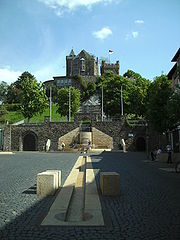
Rheinhessen (wine region)
Rheinhessen is the largest of 13 German wine regions for quality wines with under cultivation in 2008. Named for the traditional region of Rhenish Hesse, it lies on the left bank of the River Rhine between Worms and Bingen in the federal state of Rhineland-Palatinate...
, Mittelrhein
Mittelrhein (wine region)
Mittelrhein is a region for quality wine in Germany, and is located along a 120 km stretch of river Rhine in the touristic portions of the Rhine region known as Middle Rhine. On the left bank of Rhine, vineyards begin immediately downstream of the Nahe River estuary and last until Koblenz...
and Nahe
Nahe (wine region)
Nahe is a region for quality wine in Germany, along the River Nahe in the state of Rhineland-Palatinate. On the region's of vineyards in 2008, white wine grapes dominate with 75% and Riesling is the most common variety with 27.2%...
) meet. The town is also the winegrowing Bereich’s (Bereich Bingen) namesake in German wine law.
Other industries, which once did business in Bingen when there was a harbour, have left the town over the years. The service industries found here today are found mainly in the industrial park (Autobahn interchange
Interchange (road)
In the field of road transport, an interchange is a road junction that typically uses grade separation, and one or more ramps, to permit traffic on at least one highway to pass through the junction without directly crossing any other traffic stream. It differs from a standard intersection, at which...
Bingen-Ost / Kempten / Industriegebiet) and in the Scharlachberg commercial park.
Tourism also plays an important rôle.
Resident businesses
- NSM-Löwen (slot machines)
- Oerlikon Balzers Coating Germany GmbH
Rail
The main railway station, Bingen (Rhein) HauptbahnhofBingen (Rhein) Hauptbahnhof
is the Hauptbahnhof of the German city Bingen am Rhein on the West Rhine Railway. Contrary to its name, it is not located in the city centre, but in the borough of Bingerbrück...
lies in the outlying centre of Bingerbrück. It is served as a regional station by InterCity
InterCity
InterCity is the classification applied to certain long-distance passenger train services in Europe...
trains as well as one ICE line.
The railway station Bingen/Rhein Stadt lies 2 km farther east, right across from the historical harbour crane. This station is only important for local transport. Furthermore, there is also a stop in Bingen-Gaulsheim. The reason that two railway stations arose in Bingen is historical. The main railway station was originally a Prussia
Prussia
Prussia was a German kingdom and historic state originating out of the Duchy of Prussia and the Margraviate of Brandenburg. For centuries, the House of Hohenzollern ruled Prussia, successfully expanding its size by way of an unusually well-organized and effective army. Prussia shaped the history...
n border station built by the Rhenish Railway Company
Rhenish Railway Company
The Rhenish Railway Company was along with the Cologne-Minden Railway Company and the Bergisch-Märkische Railway Company one of the railway companies that in the mid-19th century built the first railways in the Ruhr and large parts of today's North Rhine-Westphalia.-Foundation :The...
on its West Rhine Railway, while the station in town belonged to the Hessian Ludwig Railway
Hessian Ludwig Railway
The Hessian Ludwig Railway or HLB with its network of 697 kilometres of railway was one of the largest privately owned railway companies in Germany.- Early history :...
.
The stops at Drususbrücke on the Bingen Hbf-Bad Kreuznach
Bad Kreuznach
Bad Kreuznach is the capital of the district of Bad Kreuznach, Rhineland-Palatinate, Germany. It is located on the Nahe river, a tributary of the Rhine...
line and Bingen-Kempten and Büdesheim-Dromersheim on the Bingen/Rhein Stadt–Alzey
Alzey
Alzey is a Verband-free town – one belonging to no Verbandsgemeinde – in the Alzey-Worms district in Rhineland-Palatinate, Germany. It is the fourth-largest town in Rhenish Hesse, after Mainz, Worms, and Bingen....
line are no longer served.
Road
Bingen lies right near Autobahnen A 60 and A 61Bundesautobahn 61
is an autobahn in Germany that connects the border to the Netherlands near Venlo in the northwest to the interchange with A 6 near Hockenheim. In 1965, this required a re-design of the Hockenheimring....
, which are linked to the town by Bundesstraße
Bundesstraße
Bundesstraße , abbreviated B, is the denotation for German and Austrian national highways.-Germany:...
9.
Water
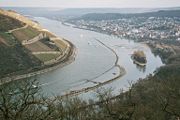
Marina
A marina is a dock or basin with moorings and supplies for yachts and small boats.A marina differs from a port in that a marina does not handle large passenger ships or cargo from freighters....
.
There are landing stages of the tourist lines Köln-Düsseldorfer, Bingen-Rüdesheimer Fahrgastschifffahrt and Rösslerlinie. A passenger ferry
Ferry
A ferry is a form of transportation, usually a boat, but sometimes a ship, used to carry primarily passengers, and sometimes vehicles and cargo as well, across a body of water. Most ferries operate on regular, frequent, return services...
and a car ferry link Bingen with Rüdesheim.
Until the late 1970s, Bingen was a piloting station.
Education
- FachhochschuleFachhochschuleA Fachhochschule or University of Applied Sciences is a German type of tertiary education institution, sometimes specialized in certain topical areas . Fachhochschulen were founded in Germany and later adopted by Austria, Liechtenstein, Switzerland and Greece...
Bingen - Stefan-George-GymnasiumGymnasium (school)A gymnasium is a type of school providing secondary education in some parts of Europe, comparable to English grammar schools or sixth form colleges and U.S. college preparatory high schools. The word γυμνάσιον was used in Ancient Greece, meaning a locality for both physical and intellectual...
- Hildegardisschule, Bishopric of Mainz Catholic private school
- Rochus-RealschuleRealschuleThe Realschule is a type of secondary school in Germany, Austria, Switzerland, and Liechtenstein. It has also existed in Croatia , Denmark , Sweden , Hungary and in the Russian Empire .-History:The Realschule was an outgrowth of the rationalism and empiricism of the seventeenth and...
- Rupertus HauptschuleHauptschuleA Hauptschule is a secondary school in Germany and Austria, starting after 4 years of elementary schooling, which offers Lower Secondary Education according to the International Standard Classification of Education...
- Berufsbildende Schule Bingen (vocational schoolVocational schoolA vocational school , providing vocational education, is a school in which students are taught the skills needed to perform a particular job...
) - Bingen town library
- Folk high schoolFolk high schoolFolk high schools are institutions for adult education that generally do not grant academic degrees, though certain courses might exist leading to that goal...
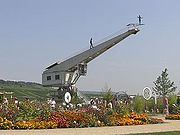
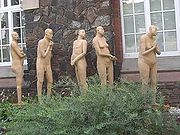
Famous people

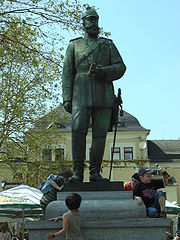
- Hildegard of BingenHildegard of BingenBlessed Hildegard of Bingen , also known as Saint Hildegard, and Sibyl of the Rhine, was a German writer, composer, philosopher, Christian mystic, Benedictine abbess, visionary, and polymath. Elected a magistra by her fellow nuns in 1136, she founded the monasteries of Rupertsberg in 1150 and...
(1098–1179), abbessAbbessAn abbess is the female superior, or mother superior, of a community of nuns, often an abbey....
and authorAuthorAn author is broadly defined as "the person who originates or gives existence to anything" and that authorship determines responsibility for what is created. Narrowly defined, an author is the originator of any written work.-Legal significance:...
, mystic, writer, composer, musician, and medic. After her the Bingen girls’ school (GymnasiumGymnasium (school)A gymnasium is a type of school providing secondary education in some parts of Europe, comparable to English grammar schools or sixth form colleges and U.S. college preparatory high schools. The word γυμνάσιον was used in Ancient Greece, meaning a locality for both physical and intellectual...
and vocational schoolVocational schoolA vocational school , providing vocational education, is a school in which students are taught the skills needed to perform a particular job...
), the Hildegardisschule (“Higa”), is named. Hildegard is said to be a people’s saint; she has, however, never been beatifiedBeatificationBeatification is a recognition accorded by the Catholic Church of a dead person's entrance into Heaven and capacity to intercede on behalf of individuals who pray in his or her name . Beatification is the third of the four steps in the canonization process...
or canonizedCanonizationCanonization is the act by which a Christian church declares a deceased person to be a saint, upon which declaration the person is included in the canon, or list, of recognized saints. Originally, individuals were recognized as saints without any formal process...
by the VaticanHoly SeeThe Holy See is the episcopal jurisdiction of the Catholic Church in Rome, in which its Bishop is commonly known as the Pope. It is the preeminent episcopal see of the Catholic Church, forming the central government of the Church. As such, diplomatically, and in other spheres the Holy See acts and...
. - Bertha of BingenBertha of BingenSaint Bertha of Bingen was the mother of Rupert of Bingen. Her biography was written, and subsequently her cult popularized, by Hildegard of Bingen, who lived in the same region, about three hundred years later...
(7th century) - Joseph Albrecht von Ittner, b. 2 March 1754, d. 9 March 1825 in KonstanzKonstanzKonstanz is a university city with approximately 80,000 inhabitants located at the western end of Lake Constance in the south-west corner of Germany, bordering Switzerland. The city houses the University of Konstanz.-Location:...
, writer - Philipp von Foltz, b. 11 May 1805, d. 5 August 1877 in MunichMunichMunich The city's motto is "" . Before 2006, it was "Weltstadt mit Herz" . Its native name, , is derived from the Old High German Munichen, meaning "by the monks' place". The city's name derives from the monks of the Benedictine order who founded the city; hence the monk depicted on the city's coat...
: painter - Ferdinand Allmann, b. 1 August 1828, d. 11 May 1912 in Bingen: Mayor of Bingen and Member of the Landstände of the Grand Duchy of HesseGrand Duchy of HesseThe Grand Duchy of Hesse and by Rhine , or, between 1806 and 1816, Grand Duchy of Hesse —as it was also known after 1816—was a member state of the German Confederation from 1806, when the Landgraviate of Hesse-Darmstadt was elevated to a Grand Duchy, until 1918, when all the German...
- Heinrich BrückHeinrich BrückHeinrich Brück was a German Catholic church historian, and Bishop of Mainz.-Life:He followed for some time the cooper's trade. After a course of studies under of a distinguished ecclesiastic, Dr. Joseph Hirschel, he entered the seminary at Mainz...
, b. 25 October 1831, d. 5 November 1903 in MainzMainzMainz under the Holy Roman Empire, and previously was a Roman fort city which commanded the west bank of the Rhine and formed part of the northernmost frontier of the Roman Empire...
: Bishop of Mainz - Johann Baptist Hilsdorf, b. 6 May 1835, d. 11 July 1918 in Bingen: photographer and father of Theodor and Jacob
- Karl Johann Brilmayer, b. 29 March 1843, d. 16 November 1905: Catholic priest, writer and Rhenish Hessian local historian
- Alice Bensheimer, b. 6 May 1864, d. 20 March 1935 in MannheimMannheimMannheim is a city in southwestern Germany. With about 315,000 inhabitants, Mannheim is the second-largest city in the Bundesland of Baden-Württemberg, following the capital city of Stuttgart....
: politician and feminist - Theodor Hilsdorf, b. 18 June 1868, d.1944: photographer
- Stefan GeorgeStefan GeorgeStefan Anton George was a German poet, editor, and translator.-Biography:George was born in Bingen in Germany in 1868. He spent time in Paris, where he was among the writers and artists who attended the Tuesday soireés held by the poet Stéphane Mallarmé. He began to publish poetry in the 1890s,...
, b. 12 July 1868, d. 4 December 1933 in MinusioMinusioMinusio is a municipality in the district of Locarno in the canton of Ticino in Switzerland.-History:In the Ceresole section, a significant Iron Age necropolis was discovered. It held about 20 graves and rich grave goods. Nearby, several Roman graveyards from the 1st and 2nd Centuries AD, were...
: German poet - Jacob Hilsdorf, b. 10 June 1872, d.1916
- Pankraz Blank, b. 30 April 1882, Member of the Landtag (Zentrum)
- Saladin Schmitt, b. 18 September 1883, d. 14 March 1951 in BochumBochumBochum is a city in North Rhine-Westphalia, western Germany. It is located in the Ruhr area and is surrounded by the cities of Essen, Gelsenkirchen, Herne, Castrop-Rauxel, Dortmund, Witten and Hattingen.-History:...
: German theatre researcher, producer and theatre manager - Fritz Nathan, b. 1891, d. 3 November 1960 in New York, NY: leading Jewish architect who designed synagogues, department stores, and the first skyscraper in MannheimMannheimMannheim is a city in southwestern Germany. With about 315,000 inhabitants, Mannheim is the second-largest city in the Bundesland of Baden-Württemberg, following the capital city of Stuttgart....
- August Weimer, b. 27 June 1908, d. 20 January 1980 in WiesbadenWiesbadenWiesbaden is a city in southwest Germany and the capital of the federal state of Hesse. It has about 275,400 inhabitants, plus approximately 10,000 United States citizens...
: trade unionTrade unionA trade union, trades union or labor union is an organization of workers that have banded together to achieve common goals such as better working conditions. The trade union, through its leadership, bargains with the employer on behalf of union members and negotiates labour contracts with...
ist and politician (CDU), Member of the BundestagBundestagThe Bundestag is a federal legislative body in Germany. In practice Germany is governed by a bicameral legislature, of which the Bundestag serves as the lower house and the Bundesrat the upper house. The Bundestag is established by the German Basic Law of 1949, as the successor to the earlier... - Philipp Anton Brück, b. 16 April 1913, d. 15 December 1984 in WormsWorms, GermanyWorms is a city in Rhineland-Palatinate, Germany, on the Rhine River. At the end of 2004, it had 85,829 inhabitants.Established by the Celts, who called it Borbetomagus, Worms today remains embattled with the cities Trier and Cologne over the title of "Oldest City in Germany." Worms is the only...
: ecclesiastical historian, librarian at the Martinus-Bibliothek - Günter Duffrer, b. 13 July 1922: docent for pastoral liturgy at the Episcopal Seminary, diocesan president of church choirs in the Bishopric of Mainz
- Claire Marienfeld, b. 21 April 1940: German politician, former Bundestag Armed Forces Commissioner
- Mary RoosMary Roos-1949-1970:Schwab was born in Bingen. At the age of nine, she recorded her first song "Ja die Dicken sind ja so gemütlich" as Die kleine Rosemarie. It was no major commercial success. In 1958, she also appeared in the film Die Straße. Over the following years she would release many records and she...
, b. 9 January 1949: German hit singer and actress - Tina York, b. 29 April 1954, German hit singer
- Thomas KlingThomas Kling- Life :Thomas Kling was born in Bingen am Rhein, grew up in Hilden and went to school in Düsseldorf. He studied Philology in Cologne, Düsseldorf and Vienna and lived in Finland for a certain period. Since 1983 he presented his poems on public performances – first in Vienna, than in the Rhineland...
, b. 5 June 1957: d. 1 April 2005 in Dormagen: German lyric poet - Peter Frey, b. 4 August 1957, German journalist
- Frank SchröderFrank SchröderFrank Schröder was an East German cross country skier who competed in the early 1980s. He won a bronze medal in the 4 x 10 km at the 1982 FIS Nordic World Ski Championships ....
, b. 2 June 1964: singer and actor - Dajan ŠimacDajan SimacDajan Šimac is a German football defender of Croatian heritage who currently plays for Debreceni VSC.-Clubs:*2001–2003 : 1...
, b. 4 January 1982: German footballer - Jan SchlaudraffJan SchlaudraffJan Schlaudraff is a German footballer who currently plays for Hannover 96, primarily as a striker.-Club career:Schlaudraff started playing professionally for Borussia Mönchengladbach, mainly as a midfielder...
, b. 18 July 1983: German footballer and first national player from Bingen
Town partnerships
HitchinHitchin
Hitchin is a town in Hertfordshire, England, with an estimated population of 30,360.-History:Hitchin is first noted as the central place of the Hicce people mentioned in a 7th century document, the Tribal Hidage. The tribal name is Brittonic rather than Old English and derives from *siccā, meaning...
, United Kingdom
United Kingdom
The United Kingdom of Great Britain and Northern IrelandIn the United Kingdom and Dependencies, other languages have been officially recognised as legitimate autochthonous languages under the European Charter for Regional or Minority Languages...
, since 1958 Nuits-Saint-Georges
Nuits-Saint-Georges
Nuits-Saint-Georges is a commune in the arrondissement of Beaune of the Côte-d'Or department in eastern France. It lies in the Burgundy region.-Wine:Nuits-Saint-Georges is the main town of the Côte de Nuits wine-producing area of Burgundy...
, France
France
The French Republic , The French Republic , The French Republic , (commonly known as France , is a unitary semi-presidential republic in Western Europe with several overseas territories and islands located on other continents and in the Indian, Pacific, and Atlantic oceans. Metropolitan France...
, since 1960 Venarey-les-Laumes
Venarey-les-Laumes
Venarey-les-Laumes is a commune in the Côte-d'Or department in eastern France.-Population:-References:*...
, France, since 1967 (originally with Bingerbrück, taken over by Bingen in 1969 Prizren
Prizren
Prizren is a historical city located in southern Kosovo. It is the administrative center of the eponymous municipality and district.The city has a population of around 131,247 , mostly Albanians...
, Kosovo
Kosovo
Kosovo is a region in southeastern Europe. Part of the Ottoman Empire for more than five centuries, later the Autonomous Province of Kosovo and Metohija within Serbia...
, since 1968

